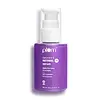What's inside
What's inside
 Key Ingredients
Key Ingredients

 Benefits
Benefits

 Concerns
Concerns

 Ingredients Side-by-side
Ingredients Side-by-side

Water
Skin ConditioningAloe Barbadensis Leaf Juice
Skin ConditioningSucrose
HumectantPropanediol
SolventSqualane
EmollientIsodecyl Neopentanoate
EmollientRetinyl Palmitate
Skin ConditioningMalus Domestica Fruit Cell Culture Extract
Skin ConditioningHydrolyzed Rice Protein
Skin ConditioningHydrolyzed Pea Protein
EmollientGlycine
BufferingProline
Skin ConditioningHydrolyzed Sodium Hyaluronate
Skin ConditioningHydrolyzed Psoralea Corylifolia Extract
Skin ConditioningBenzyl Alcohol
PerfumingHydroxyacetophenone
AntioxidantCaprylyl Glycol
EmollientXanthan Gum
EmulsifyingGlycerin
HumectantLecithin
EmollientPhenoxyethanol
PreservativeSorbitol
HumectantCyclodextrin
AbsorbentHydroxyethyl Acrylate/Sodium Acryloyldimethyl Taurate Copolymer
Emulsion StabilisingIsohexadecane
EmollientPolysorbate 60
EmulsifyingSodium Gluconate
Skin ConditioningSodium Polyacryloyldimethyl Taurate
Emulsion StabilisingAmmonium Acryloyldimethyltaurate/Vp Copolymer
Water, Aloe Barbadensis Leaf Juice, Sucrose, Propanediol, Squalane, Isodecyl Neopentanoate, Retinyl Palmitate, Malus Domestica Fruit Cell Culture Extract, Hydrolyzed Rice Protein, Hydrolyzed Pea Protein, Glycine, Proline, Hydrolyzed Sodium Hyaluronate, Hydrolyzed Psoralea Corylifolia Extract, Benzyl Alcohol, Hydroxyacetophenone, Caprylyl Glycol, Xanthan Gum, Glycerin, Lecithin, Phenoxyethanol, Sorbitol, Cyclodextrin, Hydroxyethyl Acrylate/Sodium Acryloyldimethyl Taurate Copolymer, Isohexadecane, Polysorbate 60, Sodium Gluconate, Sodium Polyacryloyldimethyl Taurate, Ammonium Acryloyldimethyltaurate/Vp Copolymer
Water
Skin Conditioning3-O-Ethyl Ascorbic Acid
Skin ConditioningPropanediol
SolventBetaine
HumectantIsodecyl Neopentanoate
EmollientEthoxydiglycol
HumectantSodium Citrate
BufferingCitric Acid
BufferingCitrus Reticulata Peel Extract
Skin ConditioningTerminalia Ferdinandiana Fruit Extract
AntioxidantRosa Damascena Extract
MaskingBenzyl Alcohol
PerfumingHydroxyacetophenone
AntioxidantCaprylyl Glycol
EmollientTrilaureth-4 Phosphate
EmulsifyingSodium Polyacryloyldimethyl Taurate
Emulsion StabilisingXanthan Gum
EmulsifyingSodium Gluconate
Skin ConditioningWater, 3-O-Ethyl Ascorbic Acid, Propanediol, Betaine, Isodecyl Neopentanoate, Ethoxydiglycol, Sodium Citrate, Citric Acid, Citrus Reticulata Peel Extract, Terminalia Ferdinandiana Fruit Extract, Rosa Damascena Extract, Benzyl Alcohol, Hydroxyacetophenone, Caprylyl Glycol, Trilaureth-4 Phosphate, Sodium Polyacryloyldimethyl Taurate, Xanthan Gum, Sodium Gluconate
Ingredients Explained
These ingredients are found in both products.
Ingredients higher up in an ingredient list are typically present in a larger amount.
Benzyl Alcohol is most commonly used as a preservative. It also has a subtle, sweet smell. Small amounts of Benzyl Alcohol is not irritating and safe to use in skincare products. Most Benzyl Alcohol is derived from fruits such as apricots.
Benzyl Alcohol has both antibacterial and antioxidant properties. These properties help lengthen the shelf life of products. Benzyl Alcohol is a solvent and helps dissolve other ingredients. It can also improve the texture and spreadability.
Alcohol comes in many different forms. Different types of alcohol will have different effects on skin. This ingredient is an astringent alcohol.
Using high concentrations of these alcohols are drying on the skin. They may strip away your skin's natural oils and even damage your skin barrier. Astringent alcohols may also irritate skin.
Other types of astringent alcohols include:
According to the National Rosacea Society based in the US, you should be mindful of products with these alcohols in the top half of ingredients.
Any type of sanitizing product will have high amounts of alcohol to help kill bacteria and viruses.
Learn more about Benzyl AlcoholCaprylyl Glycol is a humectant and emollient, meaning it attracts and preserves moisture.
It is a common ingredient in many products, especially those designed to hydrate skin. The primary benefits are retaining moisture, skin softening, and promoting a healthy skin barrier.
Though Caprylyl Glycol is an alcohol derived from fatty acids, it is not the kind that can dry out skin.
This ingredient is also used as a preservative to extend the life of products. It has slight antimicrobial properties.
Learn more about Caprylyl GlycolHydroxyacetophenone is antioxidant with skin conditioning and soothing properties. It also boosts the efficiency of preservatives.
This ingredient is not irritating or sensitizing.
We don't have a description for Isodecyl Neopentanoate yet.
Propanediol is an all-star ingredient. It softens, hydrates, and smooths the skin.
It’s often used to:
Propanediol is not likely to cause sensitivity and considered safe to use. It is derived from corn or petroleum with a clear color and no scent.
Learn more about PropanediolThis is the synthetic salt of gluconic acid, a form of PHA and mild exfoliant.
It is mainly used to stabilize oil and butter formulations from going bad. Sodium gluconate is a humectant, pH regulator, and chelating agent.
Chelating agents help neutralize unwanted metals from affecting the formulation.
Sodium gluconate is water-soluble.
Learn more about Sodium GluconateSodium Polyacryloyldimethyl Taurate is a polymer and used to help stabilize other ingredients.
Emulsion stabilizers hold ingredients together, helping to create an even texture throughout the product.
Sodium Polyacryloyldimethyl Taurate can also be used to thicken the texture.
Learn more about Sodium Polyacryloyldimethyl TaurateWater. It's the most common cosmetic ingredient of all. You'll usually see it at the top of ingredient lists, meaning that it makes up the largest part of the product.
So why is it so popular? Water most often acts as a solvent - this means that it helps dissolve other ingredients into the formulation.
You'll also recognize water as that liquid we all need to stay alive. If you see this, drink a glass of water. Stay hydrated!
Learn more about WaterXanthan gum is used as a stabilizer and thickener within cosmetic products. It helps give products a sticky, thick feeling - preventing them from being too runny.
On the technical side of things, xanthan gum is a polysaccharide - a combination consisting of multiple sugar molecules bonded together.
Xanthan gum is a pretty common and great ingredient. It is a natural, non-toxic, non-irritating ingredient that is also commonly used in food products.
Learn more about Xanthan Gum